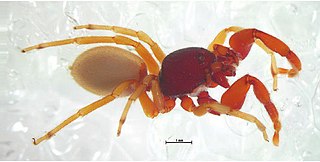
Wolf spiders are members of the family Lycosidae, from the Ancient Greek word "λύκος" meaning "wolf". They are robust and agile hunters with excellent eyesight. They live mostly in solitude and hunt alone, and do not spin webs. Some are opportunistic hunters pouncing upon prey as they find it or even chasing it over short distances. Some wait for passing prey in or near the mouth of a burrow.

Nursery web spiders (Pisauridae) is a family of araneomorph spiders first described by Eugène Simon in 1890. They resemble wolf spiders (Lycosidae) except for several key differences. Wolf spiders have two very prominent compound eyes in addition to the other six, while a nursery web spider's eyes are all about the same size. Additionally, female nursery web spiders carry their egg sacs with their jaws and pedipalps instead of attaching them to their spinnerets as wolf spiders do. When the eggs are about to hatch, a female spider builds a nursery "tent", places her egg sac inside, and stands guard outside, hence the family's common name. Like the wolf spiders, however, the nursery web spiders are roaming hunters that don't use webs for catching prey.

Oecobiidae, also called disc web spiders, is a family of araneomorph spiders, including about 100 described species. They are small to moderate sized spiders (about 2 to 20 millimetres long combined head and body length, depending on the species. Larger ones tend to be desert-dwelling. The legs are unusually evenly placed around the prosoma; most other spiders have some legs directed clearly forward and the rest clearly backward, or all forward. The first two pairs of legs of many Oecobiids point forward then curve backwards; somehow in a running spider this gives a curiously scurrying, wheel-like impression that is characteristic of many Oecobiidae, and is helpful as a rough-and-ready aid to identification in the field. Characteristic of the family is the anal gland; it bears a tuft of long hairs. Typical colour patterns range from dark-patterned cream in some smaller species, to a small number of symmetrically-placed, conspicuous round light spots on a background that may be anything from a dull orange colour to black. The carapace is rounded and bears a compact group of six to eight eyes medially situated near the front of its dorsal surface.
Bokokius is a monotypic genus of jumping spiders found only on the island of Bioko in the Gulf of Guinea. As of 2017, it contains only one species, Bokokius penicillatus. It was first described in 1942.

Microstigmatidae is a small family of spiders with about 25 described species in eight genera. They are small ground-dwelling and free-living spiders that make little use of silk.

Agelena is a genus of agelenid spiders first described by Charles Athanase Walckenaer in 1805. Sometimes referred to as Eurasian grass spiders, they trap their prey by weaving entangling non-sticky funnel webs. They are limited to the Old world, occurring from Africa to Japan.

Drassodes is a genus of ground spiders that was first described by Niklas Westring in 1851. They are brown, gray, and red spiders that live under rocks or bark in mostly dry habitats, and are generally 3.8 to 11.6 millimetres long, but can reach up to 20 millimetres (0.79 in) in length.

Idiops is a genus of armored trapdoor spiders that was first described by Josef Anton Maximilian Perty in 1833.
Sardostalita is a monotypic genus of European woodlouse hunting spiders containing the single species, Sardostalita patrizii. It was first described by F. Gasparo, who moved the sole species to its own genus when a male was discovered in 1999. It has only been found on Sardinia.
Pholcoides is a genus of Asian crevice weavers that was first described by Carl Friedrich Roewer in 1960. As of May 2019 it contains only three species: P. afghana, P. monticola, and P. seclusa.
Asiabadus is a monotypic genus of Asian ground spiders containing the single species, Asiabadus asiaticus. It was first described by Carl Friedrich Roewer in 1961, and has only been found in Central Asia and Afghanistan. It is named after Asiabad, a province in Afghanistan where they were first found, but it has been misspelled as "Asiadab" in generic and species headings.
Berinda is a genus of ground spiders that was first described by Carl Friedrich Roewer in 1928.
Afropisaura is a genus of spiders in the Pisauridae family. It was first described in 1976 by Blandin. As of 2017, it contains 3 African species.
Cispinilus is a genus of spiders in the Pisauridae family. It was first described in 1955 by Roewer. As of 2017, it contains only one species, Cispinilus flavidus, of Central Africa.
Euprosthenops is a genus of spiders in the Pisauridae family. It was first described in 1897 by Pocock. As of 2017, it contains 10 species from Africa, and one from India.
Phalaeops is a genus of spiders in the Pisauridae family. It was first described in 1955 by Roewer. As of 2017, it contains 2 African species.
Tapinothelops is a genus of spiders in the Pisauridae family. It was first described in 1955 by Roewer. As of 2017, it contains 2 African species.
Thalassiopsis is a genus of spiders in the Pisauridae family. It was first described in 1955 by Roewer. As of 2017, it contains only one species, Thalassiopsis vachoni, found in Madagascar.
Voraptipus is a genus of spiders in the Pisauridae family. It was first described in 1955 by Roewer. As of 2017, it contains only one species, Voraptipus agilis, found in Mozambique.








